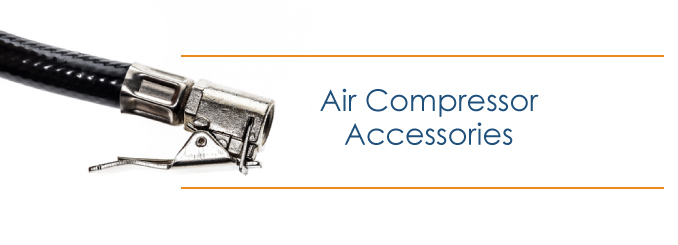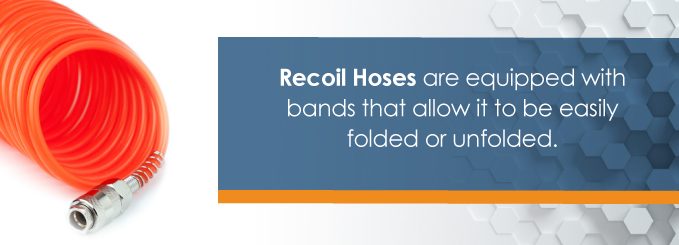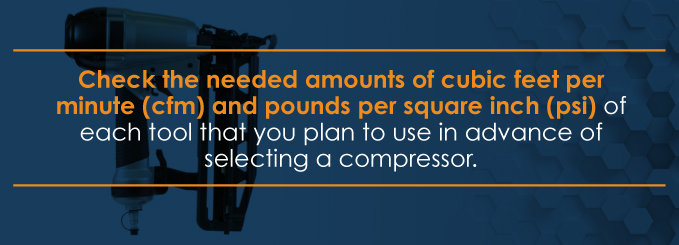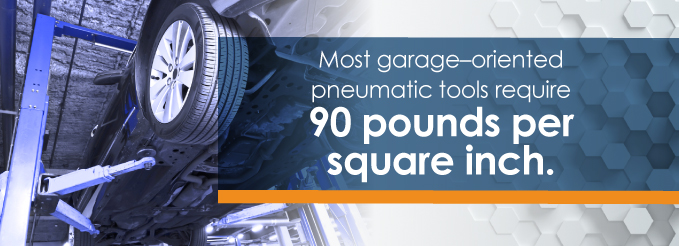
The air compressor is one of the most vital components in the modern-day industrial framework. From the cars people drive to the buildings in which people work, shop, dine and live, just about every nut, bolt and finishing job is the result of air-powered tools and machinery. Despite its vast importance, however, the air compressor would be of little use on its own. For every job in which the machine is the driving force, the air compressor accessories put the pressurized air toward specific applications.
Contact Us Learn More Find a Dealer Near You
Choose the Right Air Compressor Accessories for Your Industry
Air compressor accessories ensure a system operates at peak efficiency by helping it function more efficiently or letting employees address unexpected issues more quickly. Wherever you’re using your compressed air system, it can work even better with added parts.
It’s important to note that every industry has essential accessories that wouldn’t be appropriate for other sectors. When considering which accessories to add, think about what you need to make your industry-specific operations and end-use applications easier. You understand what you need better than anyone else but may not be sure which tool is most suitable.
Therefore, it’s important to partner with a company with the experience to advise you, such as Quincy Compressor. Be confident, but feel free to reach out and explore your options.
Best Air Compressor Attachments and Accessories
Granted, the vast range of tools and peripherals on the market can make things confusing for anyone new to the technology. People who are just starting out in this line of work often ask the same question: “What air compressor accessories do I need?” While some tools are made specifically for certain field-specific applications, the following list of compressor accessories are essential for anyone serious about using a compressor.
1. Hoses
In an air compressor setup, the hose serves as the connecting piece between the compressor itself and the pneumatic tool used for a given application. Even though most compressors come with a hose, users will often buy secondary or replacement hoses for the following reasons:
- A hose develops bends or kinks, which hamper air pressure and render an application inefficient
- A hose isn’t made from the right material type for the applications in question
- A hose lacks the volume capacity needed for a particular tool or application
- A hose is either too short or too long for a particular system setup
- A hose wears out over time from constant use
One of the most common reasons why users replace hoses is heat capacity, which might exceed the threshold of the hoses that come pre–sold with certain air compressors.
For storage purposes, hoses are designed in one of two ways:
- Retractable — a straight hose that can be wound up around a reel like a spool of thread
- Recoil — a hose equipped with bands along the length that allow it to be folded and unfolded as needed
Rubber and nylon are the two most common hose materials, but you can also purchase hoses made of PVC and polyurethane. The strongest hoses generally consist of three layers, including a weave layer for utmost protection.
How Hoses and Piping Improve Air Compressor Function
Hoses and piping are essential to any compressed air system. While standard piping is a good fit for most applications, tweaking these components can drastically improve efficiency and end-use power. For example, if you have a recently installed system with quality piping, you may still find you’re losing pressure between your compressor and end-use tools. Your piping may not be suited for your particular system and applications.
If you have an aging system, new piping could make it run like new. Years of use and subpar air quality can cause rust and other buildup to impede the flow of compressed air. While some of this can be cleaned, replacing the worn piping could be your best option. If you’ve had degraded piping for years, you may not realize how much it’s impeded system efficiency.
You can also improve energy efficiency by being mindful of your piping installation, which is especially important as energy costs rise. One horsepower from an air motor can cost you up to 8 horsepower of electrical power.
Additionally, your existing piping and air-hose installation can inhibit your growth. Although it may have been sufficient for your end-use applications previously, your business could’ve changed. Expanded piping can make your compressed air system far more versatile, and such a retrofit is more affordable than a complete system overhaul.
2. Hose Reels
When an air compressor is not in use, operators should wrap up the hose for safekeeping. For that purpose there’s the hose reel, which functions as a spool for the hose to wrap around. Hose reels come in push button and manually operated models, both of which allow for the easy retraction or release of compressor hoses.
For utmost user convenience, hose reels come in two basic designs:
- The wheel and handle variety, on which you can manually reel the hose in or out, either full or in part
- Those that feature back plates, which you can attach to a wall in your workspace for a more organized reeling setup
Hose reels also come equipped with handles and wheels, so you can transport your reeled hose between different areas or worksites. Additionally, some models feature spring assemblies, which make it possible to lock hoses at particular intervals. This is useful for situations when you only need half or one–third of the total footage of a hose extended for a given application.
3. Air Compressor Tools
Plants that don’t regularly use hand tools — such as nail guns, drills and pumps — should consider investing in them. You can never predict every need for hand tools, but performing essential repairs with your hand tool and compressed air system is time- and cost-effective. Compressed air-powered hand tools are also reliable and durable, offering a long-lasting investment.
Whether you use a compressor for furniture assembly or auto repairs, certain pneumatic tools fulfill an almost universal set of needs. Examples of tools that virtually no compressor operator can do without include:
- Nail guns: Delivering nails by coil or stick, pneumatic nail guns are used in everything from roofing and framing to construction and finishing.
- Blowguns: If there’s one tool that literally puts compressed air to use, it’s the blowgun, which applies the pressurized air straight onto surfaces for the purpose of drying, cleaning and removing dirt or dust.
- Paint sprayers: Produced with a variety of grips and applicators, paint sprayers are used for instant, even finishes along large panels of wood and metal, including machines, buildings and auto bodies.
- Drills: Pneumatic drills turn the task of driving holes through wood into a stress–free process that can be completed in seconds, with virtually no arm strain and little need for hand/eye coordination.
- Sanders: Pneumatic sanders are another tool that significantly reduce the physical strain involved in the old–fashioned manual equivalent. Whereas sand blocks can leave streaks, air–powered sanders — which are made for a variety of surfaces, including wood and metal — generally work in randomized motions that create even, streak–free finishes.
Air requirements can vary from one tool to another, so it’s crucial to check the needed amounts of cubic feet per minute (cfm) and pounds per square inch (psi) of each tool that you plan to use in advance of selecting a compressor. After all, any tool that exceeds the limits of your compressor will be rendered unusable within your arsenal.
4. Fittings and Adaptors
Occasionally, some tools won’t fit with your system’s couplings. Always have an exhaustive set of tool fittings and various-sized couplings to ensure every tool is compatible.
Invest in high-quality anodized fittings to ensure that when you make the conversion between the end-use tool and your system, it will last. While a fitting adapter may seem like a temporary fix, you can continue using it for years.
Additionally, thinking you have the right converter only to find that both ends are male is extremely frustrating. Stock up on converters based on your operation’s size. The larger your operation, the costlier unnecessary downtime will be — having the right couplers saves time and money.
Depending on the types of applications that you have in mind for an air compressor, you might need to buy additional fittings. This is typically the case where a user adds a new tool to their working arsenal, but new adaptors are required to attach the tool to a preexisting hose. Alternately, a user might buy a new hose and come to need additional fittings to connect said hose to a preexisting air compressor.
With quick connectors, you get the following benefits during each working session:
- Quick activation and turnoff
- Easy clean up and maintenance
- Simple switching between tool types
There are several things to keep in mind when selecting fittings and adaptors for your arsenal:
- Fittings and adaptors work best when they’re made by the same brand as your air compressor
- Always match and compare the size of a fitting and its correspondence to a pre-purchased hose or compressor
- Make sure that the fitting is either male or female, as needed
- Anodized fittings are generally the best choice because they resist rust formation
Certain manufacturers offer fittings and adaptors as part of conversion kits, which give you a range of fitting options for various tools, hoses and compressor connections.
5. Roll Cages
Depending on the design of an air compressor, how it’s used and settings in which it’s employed, it may be necessary to have the unit itself encased within a roll cage. Designed for protective purposes, a roll cage prevents the compressor from being shaken or knocked off balance during intensive operations. Additionally, a roll cage lowers the risk of a compressor getting punctured or incurring other sorts of damage in the course of an application.
Many air compressors come pre–fitted in roll cages, so it’s advisable to bear this feature in mind when shopping for a unit. You can also buy roll cages separately for use with pre–bought compressors. However, it’s important to look for the following qualities when buying an aftermarket roll cage:
- A low center of gravity, which generally lowers the risk of such units flipping over
- A flat, wide structure, as this allows for better ground stability
- A heavy underlying skid plate, which can boost the overall strength of the roll cage
A solid, balanced roll cage to keep your air compressor encased greatly reduces the likelihood of damage, even during the most intense of operations.
6. Filters
Throughout the complex series of processes that turn ambient air into compressed air, various impurities can enter the mix. Before the compressor delivers air to the end tool, it must remove these impurities or else applications will be rendered unsatisfactory. A leading cause of inefficient and underpowered compressed air systems is dirty filters.
With the use of a filter on your air compressor, unwanted elements are removed from the process and applications run smoother and more efficiently.
The impurities that are known to corrupt the process of a compressed air system consist primarily of the following elements:
- Moisture: In hot settings, moisture can be present in the ambient air that enter a compressor’s inlet valve.
- Condensate: This is inevitable in most compressors due to the intense heat generated by the process.
- Oil: Oil can seep into compressed air from the lubricated inner mechanisms. It can also arrive through the inlet via airborne particulates
- Gases: These can get drawn into the compressor and infect the resulting air with musty smells and harmful contaminants
The majority of air compressors come equipped with filters, but replacements are necessary over time, as filters wear out due to trapped impurities. For added dryness, most of today’s filters are also equipped with desiccants, which absorb moisture from the air.
7. Air Regulators
An air pressure regulator gives an accurate reading of usable air pressure within your end-use tools. While you may set your central compressor for a certain pressure, several variables can drastically reduce air pressure, lowering efficacy and energy efficiency. A regulator provides the necessary insights to maximize system efficiency without impeding efficacy.
The pressure requirements of a given tool can differ from the amount delivered by a compressor. For example, while most garage-oriented pneumatic tools require 90 pounds per square inch, most air compressors run at 150 psi or higher to meet the demands of more high-powered tools. As such, certain tools end up taking more pressure than they need, wasting compressed air in the process.
With an air regulator, the following advantages are gained during compressed air applications:
- Air tools such as grinders, sanders, drills and riveters are given the right amounts of pressure
- Compressed air is conserved during the course of a given application
- Tools and hoses are subject to less wear caused by excess amounts of pressure
Air compressors are designed to compress endless volumes of air. Even though large amounts of this air don’t end up used on applications, waste levels can be reduced with the use of an air regulator. For the average user, the advantages can be significant, because when the pressure levels applied to a given tool are curbed accordingly, operations are carried out with money–saving efficiency.
8. Air Line Lubricators
Machinery depends on oil, which allows the joints of metal parts to move and rub against one another without causing friction or corrosion. In an air compressor, various parts run simultaneously throughout each stage of the process that turns ambient air from the inlet into compressed air for pneumatic applications. The purpose of an air line lubricator is to ensure the oil is sent in sufficient quantities to all the needed spots in an air compressor.
With an airline lubricator, you’ll know that your air compressor:
- Receives proper amounts of oil in all the right places on an as–needed basis
- Doesn’t wear down internally due to insufficient lubrication in the areas that need it most
- Performs optimally throughout applications of any given level of intensity
Granted, it’s crucial that an air line lubricator be set to an appropriate level so that only proper amounts of oil are distributed. Otherwise, the machine could release excess amounts of oil. This, in turn, could lead to airborne oil and all the problems that entails, such as a polluted working area and spoiled pneumatic applications.
9. Aftercoolers
Due to the intensity of the processes that occur in an air compressor, considerable levels of heat and vapor content are contained in compressed air. In order for the air to actually be useable in most applications, reductions are needed in both the heat and vaporization before the air reaches the tool tip. For both of these purposes, an aftercooler is essential to the process of compressing air.
Each time you use an air compressor, an aftercooler performs the following functions:
- The compressed air is lowered to a suitable temperature for pneumatic applications
- Vapor is extracted from the air and turned into water for convenient drainage
- Compressed air is rendered stronger due to the increased ratio of air molecules
Thanks to the de-vaporization performed by an aftercooler, compressed air contains more pure air per cubic foot, which equals higher pressurization. Therefore, an aftercooler boosts the efficiency of an air compressor by making the resultant air more powerful.
10. Portable Air Tanks
A portable air tank or an individual portable compressor keeps you running even when your main compressor is down.
Portable air tanks store compressed air generated by your main compressor, which can power end-use tools when your compressor isn’t active. While they can’t power your entire operation, they can maintain essential tasks while you repair your main compressor.
In contrast, portable compressors generate the compressed air you need for bigger operations. These are especially useful for unexpected main compressor failures and maintain end-use applications.
Buy Air Compressor Accessories From Quincy Compressor
Air compressors streamline productivity at numerous levels in the commercial and industrial sectors. Whether you operate a small repair shop or a large production facility, an air compressor will help you finish work faster with a higher degree of perfectionism. Depending on the applications employed in your field of work, you’ll also need an arsenal of accessories at hand to harness the power of your compressor.
For nearly a century, Quincy Compressor has provided air compressors and accessories to craftspeople and industrialists. From auto repair shops to pressing plants, our machines have driven productions across the U.S. and abroad. To learn more about the vast range of air compressors and accessories in our inventory, click on over today to our sales and service locator page.





